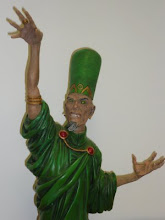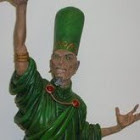 A hugely enjoyable and engaging alternative Sherlock Holmes story that confidently moves the cast to different time and context. John Watson is a medical intern in the Convent Emergency Center , Harlem , New York where he meets Sherlock Holmes who arrives inquiring about a patient who has just been brought in. Holmes makes a suggestion regarding the patient that Watson follows up and this pushes him to visit Holmes at Hudson's Bookshop, 221b Baker Street Harlem. The case and Watsons's involvement develops very nicely as an extensive and very dangerous conspiracy becomes clear and arrives at a very satisfactory conclusion.
A hugely enjoyable and engaging alternative Sherlock Holmes story that confidently moves the cast to different time and context. John Watson is a medical intern in the Convent Emergency Center , Harlem , New York where he meets Sherlock Holmes who arrives inquiring about a patient who has just been brought in. Holmes makes a suggestion regarding the patient that Watson follows up and this pushes him to visit Holmes at Hudson's Bookshop, 221b Baker Street Harlem. The case and Watsons's involvement develops very nicely as an extensive and very dangerous conspiracy becomes clear and arrives at a very satisfactory conclusion.The cast are superb. The headline is that both Watson and Holmes are New York African Americans and the story has a powerful New York context. What matters is the joyous confidence with which Karl Bollers has written Watson and Holmes, the way that they interact with each other, respond to changing circumstances and in particular the way that John Watson is developed and presented is a huge pleasure. They are utterly true to themselves and their context, the essential details of a Sherlock Holmes story are presented with tremendous understated skill, none are blatantly highlighted and shoved at the reader, they are stitched firmly into the story. Best of all is the key relationship between Watson and Holmes, it is natural and unforced, the motivations for both that underlie their friendship is neatly set up.
The art by Rick Leonardi in the main story is a pleasure to read, it is full of details that firmly anchor the cast in a physical location, the cast are expressive, the body language is eloquent. The cast, including the walk on parts, are all individual, there are no generic characters. They all demand the readers attention without crowding out the action. The quiet moments are as interesting as the action, the cast are interested in what they are saying and that brings the reader into the moment.
In the Epilogue, Larry Stroman's art is distinctively different and equally effective, he captures the tension that runs through a sharp and bitter story that packs a considerable punch in a short space.
The colouring captures the emotional tones of the story and highlights the relevant details with subtle care and craft. This is a noir version of Holmes, the story is dark and even in the light of day there are deep shadows. The colouring shifts tones that track the tone of the story without shouting it, they frame the action and engage the reader.
This is a superb Holmes story, confidently taking the ideas and using them in a engaging and enjoyable way, a pleasure.


No comments:
Post a Comment